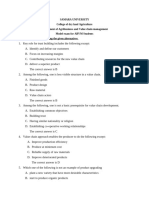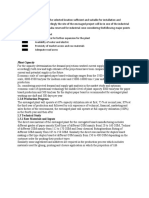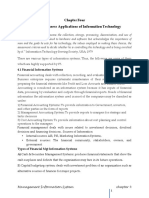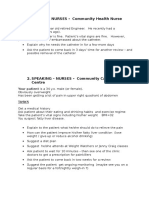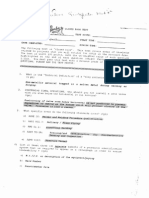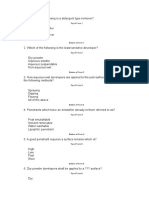0 ratings0% found this document useful (0 votes)
1K viewsAnswers Are Here : OPS 571 Final Exam
Answers Are Here : OPS 571 Final Exam
Uploaded by
JithuJohnThis document provides answers to a 39 question OPS 571 final exam covering topics like operations processes, quality management, forecasting, inventory management, and aggregate production planning. Some key points addressed include:
- Make-to-stock processes can be controlled based on finished goods levels and are common for services.
- Throughput time is the most common process metric.
- Blocking occurs when activities must stop due to lack of space to deposit completed items.
- Time-to-market is the most important performance dimension for new product development projects.
- Quality Function Deployment translates customer needs into engineering goals.
Copyright:
© All Rights Reserved
Available Formats
Download as DOCX, PDF, TXT or read online from Scribd
Answers Are Here : OPS 571 Final Exam
Answers Are Here : OPS 571 Final Exam
Uploaded by
JithuJohn0 ratings0% found this document useful (0 votes)
1K views10 pagesThis document provides answers to a 39 question OPS 571 final exam covering topics like operations processes, quality management, forecasting, inventory management, and aggregate production planning. Some key points addressed include:
- Make-to-stock processes can be controlled based on finished goods levels and are common for services.
- Throughput time is the most common process metric.
- Blocking occurs when activities must stop due to lack of space to deposit completed items.
- Time-to-market is the most important performance dimension for new product development projects.
- Quality Function Deployment translates customer needs into engineering goals.
Original Description:
ops57
Original Title
ops57
Copyright
© © All Rights Reserved
Available Formats
DOCX, PDF, TXT or read online from Scribd
Share this document
Did you find this document useful?
Is this content inappropriate?
This document provides answers to a 39 question OPS 571 final exam covering topics like operations processes, quality management, forecasting, inventory management, and aggregate production planning. Some key points addressed include:
- Make-to-stock processes can be controlled based on finished goods levels and are common for services.
- Throughput time is the most common process metric.
- Blocking occurs when activities must stop due to lack of space to deposit completed items.
- Time-to-market is the most important performance dimension for new product development projects.
- Quality Function Deployment translates customer needs into engineering goals.
Copyright:
© All Rights Reserved
Available Formats
Download as DOCX, PDF, TXT or read online from Scribd
Download as docx, pdf, or txt
0 ratings0% found this document useful (0 votes)
1K views10 pagesAnswers Are Here : OPS 571 Final Exam
Answers Are Here : OPS 571 Final Exam
Uploaded by
JithuJohnThis document provides answers to a 39 question OPS 571 final exam covering topics like operations processes, quality management, forecasting, inventory management, and aggregate production planning. Some key points addressed include:
- Make-to-stock processes can be controlled based on finished goods levels and are common for services.
- Throughput time is the most common process metric.
- Blocking occurs when activities must stop due to lack of space to deposit completed items.
- Time-to-market is the most important performance dimension for new product development projects.
- Quality Function Deployment translates customer needs into engineering goals.
Copyright:
© All Rights Reserved
Available Formats
Download as DOCX, PDF, TXT or read online from Scribd
Download as docx, pdf, or txt
You are on page 1of 10
OPS 571 Final Exam
ANSWERS ARE HERE
1. Which of the following is true about make-to-stock processes?
A. Make-to-stock processes can be controlled based on the actual or anticipated amount of finished
goods
B. Make-to-stock process is used when demand is seasonal and the firm does not have enough
C. Services by their very nature often use make-to-stock processes.
D. A and B
2. According to your text, the most common process metric is:
A. Productivity
B. Utilization
C. Throughput time
D. Efficiency
3. ________ is when the activities in the stage must stop because there is no place to deposit the item
just completed.
A. Buffering
B. Starving
C. None of these answers
D. Blocking
4. According to Hayes and Wheelwright, which of the following is not a major process flow structure?
A. Job Shop
B. Assembly Line
C. Project
D. Batch
5. The most important performance dimension for product development projects is
A. Quality
B. Product flexibility
C. Time-to-market
D. Productivity
6. The major decision variables in equipment selection are:
A. Flexibility
B. Labor requirements
C. Manufacturer
D. Both A and B
7. Quality Function Deployment:
A. is a tool for translating customer requirements into concrete operating and engineering goals.
B. facilitates inter-functional cooperation between marketing, engineering, and manufacturing.
C. provides a better understanding and focus on process characteristics that require improvements.
D both a and B.
8. Which of the following statements is true about value analysis/value engineering?
A. the purpose of VA/VE is to simplify products and processes.
B the objective of VA/VE is to achieve equivalent or better performance at a lower cost.
C. VA is performed before the production stage, while VE deals with products already in production.
D both A and B.
9. In which phase of new-product design process are considerations to target market, desired level of
performance, investment requirements and financial impact made:
A. detailed engineering.
B. Preliminary process design.
C. pilot manufacturing phase.
D. concept development and product planning.
10. Which of the following is not a dimension of design quality?
A. Durability.
B. Serviceability.
C. Customization.
D. Features.
11. Testing is an example of:
A. Prevention costs.
B. Internal Failure costs.
C. External Failure Cost.
D. Appraisal costs.
12. Which Quality Guru advocated that senior management is responsible for 94% of quality problems?
A. Deming.
B. Ishikawa.
C. Juran.
D. Crosby.
13. Independent Demand is:
A. demand that is related to the demand for another item.
B. demand determined by the marketplace that requires forecasting.
C. Inventory whose demand comes from independent suppliers.
D. Inventory that is independent of any known rules of demand and supply.
14. Which of the following statements is true about the Q-system?
A. It does not have an EOQ, since the quality varies according to the demand.
B. The order interval is fixed not the order quanity.
C. It does not have a reorder point but rather a target inventory.
D. The system is completely determined by the two parameters, Q and R.
15. Which of the following is not an assumption of the basic economic-order quantity model?
A. ordering or setup costs are constant.
B. Quantity discounts are available.
C. annual demand is constant and known.
D. lead time is constant.
16. Which of the following is not a principle of work-center scheduling?
A. Schedule jobs as strings, with process steps back to back.
B. Obtain feedback each day on the jobs that are completed at each work center.
C. Once started, a job should not be interrupted.
D. Reschedule every day.
17. The assignment method is appropriate in solving problems that have the following characteristics?
A. There are n things to be distributed to n destinations.
B. Though each destination may handle all the things, the final assignment has each thing assigned to
one and only one destination.
C. Only one criterion should be used (minimum cost, maximum profit, for example).
D. A and C.
18. The objective of work-center scheduling include(s):
A. To meet due dates.
B. To minimize lead times.
C. To minimize finish goods inventory.
D. Both A and B.
19. The measure of the firms ability to make money according to Goldratt include:
A. Net profit.
B. Return on assets.
C. Cash flow.
D. Both A and C.
20. Goldratts rule of production scheduling include all but:
A. An hour saved at a non-bottleneck is a marriage.
B. A process batch should be fixed both along its route and in time.
C. Do not balance the capacity-balance the flow.
D. Utilization and activation of a resource is not the same thing.
21. According to Goldratt and Fox, a useful performance measure to treat inventory is:
A. Quick ratio.
B. Dollar days.
C. Inventory turnover.
D. Current ratio.
22. The advantages of pure project include all but:
A. Decisions are made quickly.
B. A team member can work on several projects.
C. The project manager has full authority over the project.
D. Team pride, motivation, and commitments are high.
23. Which of the following is not a typical milestone?
A. Training of project members.
B. Completed testing of the prototype.
C. Completion of design.
D. Production of a prototype.
24. Slack refers to the difference between:
A. Observed and predicted times.
B. optimistic and pessimistic times.
C. Latest and earliest times.
D. finish and start times.
25. Which of the following statements are true about time-series forcasting?
A. Time series analysis is based on the idea that the history of occurrences over time can be used to
predict the future.
B. Agent liability. Time series analysis tries to understand the system underlying and surrounding the
item being forecast.
C. Under time-series methods, demand is divided into the time-based components such as daily, weekly,
etc.
D. Time series methods are useful for long-range forecasts when the demand pattern is erratic.
26. Which of the following product promotional activities would probably help make the supply chain
more efficient?
A. Special packaging for a specific event that occurs one time each year.
B. A 2 for 1 price promotion.
C. Price promotions that expire on a specific date.
D. An everyday low price strategy where prices are not dependent on quantity delivered with a
specific order.
27. According to Hau Lee, which of the following types of products need to be delivered with efficient
supply-chains?
A. Grocery Products.
B. High technology products.
C Customer products.
D. Innovative products.
28. Supply-chain response relates to the following?
A. How quickly a customer order can be filled.
B. How quickly a company can react to a new competing product.
C. How inexpensive the product is.
D. Both A and B.
29. Which of the following statements is not true about capacity management in operations?
A. Capacity planning itself has different meaning to individual at different levels within the operations
management hierarchy.
B. the definition of capacity, in an operations management context, makes a clear distinction between
efficient and inefficient use of capacity.
C. When looking at capacity, operations managers need to look at both resource input and product
outputs.
D. An operations management view also emphasizes the dimension of capacity.
30. Capacity utilization rate can be computed as:
A. Capacity used-best.
B. Capacity used x best.
C. Capacity used/best.
D. Capacity used + best.
31. Lean systems typically require?
A. delivery of large lots at frequent intervals.
B Buyer inspection of goods and materials.
C. multiple sources from which to purchase.
D. long-term relationships and commitments.
32. Which of the following is not true about JIT systems?
A. The JIT system is based on the philosophy of eliminating waste and utilizing the full capacity of the
worker.
B. Under JIT the ideal lot size is one.
C. JIT is typically applied to repetitive manufacturing.
D. The goal of JIT is to drive all inventory queues to a moderate level thus minimizing inventory
investment and shortening lead times.
33. Which of the following is not an element of JIT?
A. small-lot production.
B. quickly changing schedule.
C. Multifunction worker.
D. Kanan pull system.
34. Which of the following would not be classified as a time-series technique?
A. Simple moving average.
B. Exponential smoothing.
C. Box Jenkins technique.
D. Regression model.
35. Which phase most closely describes the Delphi forecasting technique?
A. consumer survey.
B. random individual opinions.
C. group of experts opinions.
D. test markets.
36. Aggregate planners balance?
A. demand and costs.
B. demand and inventories.
C. demand and capacity.
D. supply and inventories.
37. Which of the following accurately descrives a chase strategy?
A. The firms produces the same amount each day over the planning period and deals with the variations
in demand through the use of inventory or overtime.
B. The firm produces at the same level for several months, and then adjusts production to another level
and produces at that level for several more months.
C. The firm produces exactly what is needed each month.
D. All of the above could describe the strategy depending on the organization.
38. Which of the following is not a cost relevant to aggregate production planning?
A. Basic production costs.
B. Quantity discounts.
C. Cost associated with changes in the production rate.
D. Inventory holding costs.
39. Which MRP system input element specifies how many and when the firm plans to build each end
item?
A. Master Production schedule.
B. Bill of Material.
C. Inventory records file.
D. Capacity Planning.
40. Which of the following most closely describes net material requirements?
A. gross requirements-on hand-planned order receipts.
B. gross requirements-on-hand+ planned order receipts.
C. gross requirements-planned order receipts.
D. gross requirements-planned order releases.
41. Which of the following is not an advantage of MRP?
A. Reduced idle time.
B. Reduced inventory.
C. Reduced sales price.
D. MRP is flexible-easy to veer away from the schedule is need arises.
42. The steps to determining capacity requirements include:
A. Using decision trees to evaluate capacity alternatives
B. Calculating equipment and labor requirements to meet product line forecasts
C. Projecting labor and equipment availabilities over the planning horizon
D. B and C
43. Service capacity
A. is highly time and location dependent
B. is subject to less volatile demand fluctuations
C. utilization directly impacts service quality
D. A and C
You might also like
- Compare The Forecasting Methods On The Basis of BIAS, MAD, MSE, MAPE, and Tracking SignalDocument13 pagesCompare The Forecasting Methods On The Basis of BIAS, MAD, MSE, MAPE, and Tracking Signalkamrul hasanNo ratings yet
- Pressure Vessel Exm QuestionsDocument4 pagesPressure Vessel Exm QuestionsJithuJohn100% (2)
- Answers Are Here !!! OPS 571 Final EXAMDocument4 pagesAnswers Are Here !!! OPS 571 Final EXAMMansoor AliNo ratings yet
- 303 60 MCQs POM BBA 303 BBA V Dec 2021Document11 pages303 60 MCQs POM BBA 303 BBA V Dec 2021Fentahun Ze WoinambaNo ratings yet
- Bba Semester Vi Core 18 - Production Management Multiple Choice QuestionsDocument21 pagesBba Semester Vi Core 18 - Production Management Multiple Choice QuestionsRama DeviNo ratings yet
- Production and Operation ManagementDocument22 pagesProduction and Operation ManagementSandeep JainNo ratings yet
- ESE - Dec22 - MBA - ALL - Operations ManagementDocument7 pagesESE - Dec22 - MBA - ALL - Operations ManagementSaroj AndhariaNo ratings yet
- Ellu 12Document7 pagesEllu 12Hassen GireNo ratings yet
- OM Midterm Exam PDFDocument7 pagesOM Midterm Exam PDFJonnel Sadian Acoba100% (1)
- Bahir Dar University College of Business and Economics EMBA ProgramDocument3 pagesBahir Dar University College of Business and Economics EMBA ProgramaleneNo ratings yet
- Employee and Employer Relation Ship in Publc Service EnterprDocument47 pagesEmployee and Employer Relation Ship in Publc Service EnterprZoe Path50% (2)
- Tossa College of Economic DevelopmentDocument2 pagesTossa College of Economic DevelopmentAbdurohman80% (5)
- Multiple Choice QuestionsDocument9 pagesMultiple Choice QuestionsReymark MutiaNo ratings yet
- Family KapDocument87 pagesFamily KapmansirimamraddaNo ratings yet
- Assignment C DDocument4 pagesAssignment C DShahulHameedNo ratings yet
- @4 Auditing and Assurance Services - WSUDocument125 pages@4 Auditing and Assurance Services - WSUOUSMAN SEIDNo ratings yet
- MGMT 432 - Operations Management AssignmentDocument10 pagesMGMT 432 - Operations Management AssignmentYohannes SharewNo ratings yet
- QUESTION - Strategic Management AssignmentDocument2 pagesQUESTION - Strategic Management AssignmentJames Selase AkpoNo ratings yet
- ManagementDocument20 pagesManagementSifan Muleta100% (1)
- OM Assignment NewDocument37 pagesOM Assignment NewBisrat nigusuNo ratings yet
- Course Title Buss. IntellegencyDocument5 pagesCourse Title Buss. IntellegencyTemesgen EbaNo ratings yet
- Sample Questions T. Y. B. Com. (SEM V) Cost Account: C. Manual RegisterDocument6 pagesSample Questions T. Y. B. Com. (SEM V) Cost Account: C. Manual RegisterYash PardeshiNo ratings yet
- Chapter-Two Environments of HRMDocument20 pagesChapter-Two Environments of HRMMan TKNo ratings yet
- Great Land College Post Graduate StudiesDocument21 pagesGreat Land College Post Graduate StudiesMelikteNo ratings yet
- DR Biniam B Quantitative Analysis AssignmentDocument5 pagesDR Biniam B Quantitative Analysis AssignmentAmanuel Markos0% (1)
- EOC Questions: Dr. Faouzi MaddouriDocument6 pagesEOC Questions: Dr. Faouzi MaddouriTara Mecca LunaNo ratings yet
- Assignment OTDocument2 pagesAssignment OTshalukpr100% (3)
- MCQ - PlanningDocument1 pageMCQ - Planninglorrynorry75% (4)
- MGT Jimma 2Document42 pagesMGT Jimma 2Amir sabir100% (1)
- Entrepreneurship and Enterprise Development Final ExamDocument3 pagesEntrepreneurship and Enterprise Development Final ExammelakuNo ratings yet
- Project Preparation: Unit FourDocument37 pagesProject Preparation: Unit FourTemesgen100% (1)
- Management MCQ SolutionsDocument10 pagesManagement MCQ SolutionsSubhojit Mukherjee0% (1)
- Rift Valley UniversityDocument22 pagesRift Valley UniversityMagarsa BedasaNo ratings yet
- Individual Assignment On Chapter One-OBDocument6 pagesIndividual Assignment On Chapter One-OBDawit AsmelashNo ratings yet
- AnswerDocument13 pagesAnswerPhan NhấtNo ratings yet
- OM Awash Assignment 2Document2 pagesOM Awash Assignment 2zekariyas mellese100% (1)
- Chapter Five The Nature of Strategy Analysis and ChoiceDocument10 pagesChapter Five The Nature of Strategy Analysis and ChoiceBedri M AhmeduNo ratings yet
- Rift Valley UniversityDocument8 pagesRift Valley UniversityLily Eudaimonia SolomonNo ratings yet
- Case Beijing Sammies QuestionsDocument1 pageCase Beijing Sammies QuestionsMehr FaisalNo ratings yet
- Marketing Environmental Analysis A StudyDocument30 pagesMarketing Environmental Analysis A StudyAmdework100% (1)
- Kaleab Propopsa LDocument7 pagesKaleab Propopsa Lmubarek oumerNo ratings yet
- ABVM Model ExamDocument42 pagesABVM Model Exambirukbizuneh6No ratings yet
- Chapter Seven: Service Development and DesignDocument20 pagesChapter Seven: Service Development and DesignBura Arsenal100% (1)
- Non-Discounting Criteria Discounting CriteriaDocument89 pagesNon-Discounting Criteria Discounting CriteriaAytenew AbebeNo ratings yet
- Chap13 MC Questions&AnswersDocument5 pagesChap13 MC Questions&AnswersDebarpitaa RoyNo ratings yet
- Query LanguageDocument44 pagesQuery Languagejerin joshyNo ratings yet
- Site: Is A Plot of Land Within The Selected Location Sufficient and Suitable For Installation andDocument6 pagesSite: Is A Plot of Land Within The Selected Location Sufficient and Suitable For Installation andmesfin esheteNo ratings yet
- ProductivityDocument17 pagesProductivitygetahun2001100% (1)
- MM ch2Document18 pagesMM ch2thebestofworld2014No ratings yet
- Ob QBDocument20 pagesOb QBSelva KumarNo ratings yet
- Oda Bultum University: Project InitiatorDocument16 pagesOda Bultum University: Project InitiatorMoon Sun100% (1)
- Chapter 7 Material Requirement Planning (MRP)Document18 pagesChapter 7 Material Requirement Planning (MRP)opio james50% (2)
- Proposal of Mohammed - HusenDocument21 pagesProposal of Mohammed - HusenHamral TemamNo ratings yet
- Chapter Four Common Business Applications of Information TechnologyDocument14 pagesChapter Four Common Business Applications of Information TechnologyHayelom Tadesse GebreNo ratings yet
- Quali - 1Document4 pagesQuali - 1everytimeyoulieNo ratings yet
- CH 1 KeyDocument14 pagesCH 1 KeyCandice50% (2)
- Production Planning and Scheduling Complete Self-Assessment GuideFrom EverandProduction Planning and Scheduling Complete Self-Assessment GuideNo ratings yet
- Will Begin D. A and BDocument4 pagesWill Begin D. A and BJohn StephensNo ratings yet
- Basics of Supply Chain Management: Practice TestDocument5 pagesBasics of Supply Chain Management: Practice TestkamranNo ratings yet
- Industrial Management and Engineering Economics TutorialDocument14 pagesIndustrial Management and Engineering Economics Tutorialyiheyis mulatuNo ratings yet
- General Questions4Document31 pagesGeneral Questions4JithuJohnNo ratings yet
- 1-3 Email Nurse - Role PlayDocument2 pages1-3 Email Nurse - Role PlayJithuJohnNo ratings yet
- General Questions4Document31 pagesGeneral Questions4JithuJohnNo ratings yet
- 2015 Rev-Ect Feb 17 ListDocument7 pages2015 Rev-Ect Feb 17 ListJithuJohnNo ratings yet
- General Questions4Document31 pagesGeneral Questions4JithuJohnNo ratings yet
- General Questions4Document31 pagesGeneral Questions4JithuJohnNo ratings yet
- Material With Electrode SelectionDocument2 pagesMaterial With Electrode SelectionJithuJohn100% (4)
- Aramco QuestionDocument72 pagesAramco QuestionZuberYousuf100% (1)
- PG Nursing Noti-APRIL - 2016Document7 pagesPG Nursing Noti-APRIL - 2016JithuJohnNo ratings yet
- Line Pipe API 5lDocument3 pagesLine Pipe API 5lJithuJohnNo ratings yet
- OET Test 3 Listening Answers - Part A and BDocument6 pagesOET Test 3 Listening Answers - Part A and BJithuJohn100% (1)
- Aramco QuestionDocument72 pagesAramco QuestionZuberYousuf100% (1)
- VT No: 1Document12 pagesVT No: 1JithuJohnNo ratings yet
- Rtliiim2: 20ci SourceDocument1 pageRtliiim2: 20ci SourceJithuJohnNo ratings yet
- Subject Group of Materials Science and EngineeringDocument2 pagesSubject Group of Materials Science and EngineeringJithuJohnNo ratings yet
- Dpi QDocument4 pagesDpi QJithuJohnNo ratings yet









































